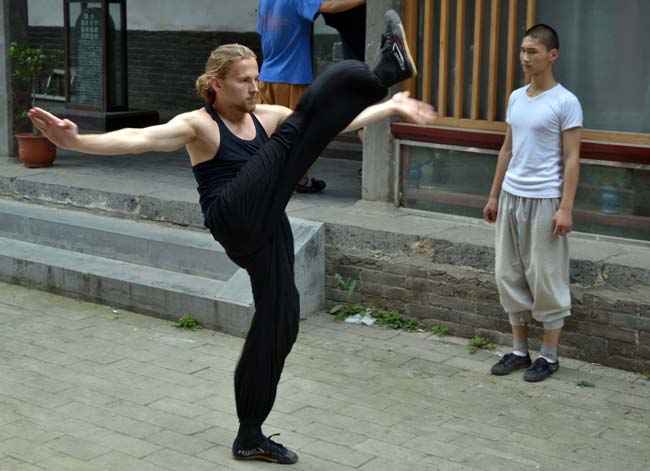Shaolin: Fists of fame
Updated: 2014-07-28 07:28
By Hou Liqiang and Qi Xin (China Daily)
|
|||||||||||
 |
| Russian kung fu practitioner Maxim Kojevnikoff warms up in Shaolin Temple on July 3. PHOTOS BY HOU LIQIANG / CHINA DAILY |
|
Dengfeng opens arms to kung fu students from US By Qi Xin and Zhao Xinying Dengfeng, a small and quiet city in Henan province that is home to the Shaolin Temple, has been busy with the arrival of high school students from the United States who want to learn kung fu. As part of the Chinese Bridge Summer Camp for US High School Students, which has been held annually since 2007 by Hanban, or the Confucius Institute Headquarters, the kung fu-learning section lasted from July 20 to 23 and was attended by 107 US high school students. Alex Frol, an 18-year-old from Oregon, was one of them. The recent high school graduate was born without her right leg and has been walking with the help of an artificial limb. But her disability does not stop her from enjoying the pleasure of practicing kung fu. "I like kung fu, because it's real fun, and I enjoy meeting the challenge to see whether I can overcome it or not. If I can overcome it, I will become much better," she said. "I also like my kung fu teacher. He tells me I am very good, and I appreciate him. I only practice kung fu for a couple of days," she said, adding that in the US it can only be learned in larger cities. Pamela Herron, a teacher at the University of Texas at El Paso, said she was excited about visiting the Shaolin Temple and learning Shaolin kung fu. "Everyone knows the Shaolin Temple and Shaolin kung fu from the movies," said Herron, who visits China often and whose husband is Chinese. "It is very beautiful here, and I like the countryside and the mountains," she said. But the camp is not solely about learning kung fu. "We try to integrate the teaching of kung fu with Chinese-language instruction and the introduction of Chinese culture, believing that students who are interested in kung fu can acquire Chinese language skills and culture at the same time," said Guo Aixian, deputy director of Songshan Shaolin Wushu Vocational Institute. The institute is a school in Dengfeng responsible for teaching Shaolin kung fu. Herron said they hoped that during the process the students would be excited about learning Chinese. "In China, the students can learn Chinese by talking to Chinese people and hearing the language. When they go back home, they will motivate other students," she said. "We also order them to hand in an essay of at least 300 words in Chinese to describe their feelings. It is a good way to improve their Chinese," she added. Frol said she has picked up a few words by hearing people talking. "It is so cool," she said. "I am not good at it at all, but I will try. I want to say ni hao (hello) and zaoshang hao (good morning) to people here," she said. Scott Richter, a 17-year-old from Oregon, said Chinese is his second language and he has been studying it for almost five years. "I can't speak it very well," he said in Chinese. "But I'm trying to practice more by having lunch with my Chinese friends. Communication helps me make progress." Contact the writers at qixin@chinadaily.com.cn and zhaoxinying@chinadaily.com.cn |
"Shaolin Temple has emphasized exchanges with different cultures in its 1,500 years and held on to the belief that only communication can result in development," he said.
Liu Yi, deputy dean of the physical culture institute at Hubei University, said people can learn Shaolin kung fu in many training schools, but the temple is the most attractive place for foreigners and visitors because of the culture it represents."In Shaolin Temple, kung fu is combined with Chan Buddhism. It includes many aspects of traditional Chinese culture, such as having a strong sense of justice and being ready to help the weak," Liu said.
Many foreigners go to Shaolin not to learn kung fu to fight or defend themselves, but to learn more about these aspects of traditional Chinese culture, Liu said.
Hong Hao, head of the department of physical education at Henan University, said that Shaolin kung fu's combination with Chan Buddhism, which emphasizes meditation, can also make it popular in the West.
Shaolin kung fu can help people in the West who suffer from the fast pace of a competitive society by taking it slow to contemplate life and the value of their existence, he said.
Practicing the martial art can also help foreigners understand Chinese culture better through body language and physical expressions, Hong said.
But the temple needs to continue improving itself, he said. Many people teach its kung fu but there is no uniform standard. That may hinder its popularization, he said.
There are also no specialized teachers of the martial art. The monks are good at kung fu but they might not know how to teach it systematically. The temple also needs to pay more attention to the theoretical study of kung fu, he said.
Contact the writers at houliqiang@chinadaily.com.cn
Today's Top News
Developers placing bets on casinos overseas
Scrutiny on iPhone data access
Russian fighter jet crash kills pilot
US-Russia relations frosty
Harsher safety measures urged amid scandal
Drills to have 'little impact' on civilian air services
Revision of decree protects military airports
Experts slam Japan's bid to break order
Hot Topics
Lunar probe , China growth forecasts, Emission rules get tougher, China seen through 'colored lens', International board,
Editor's Picks

|

|

|

|

|

|





